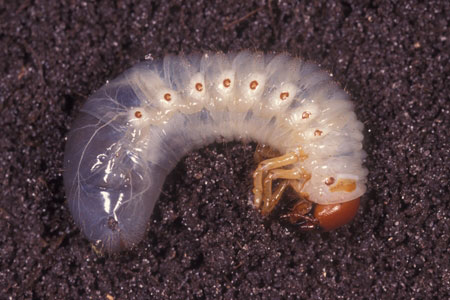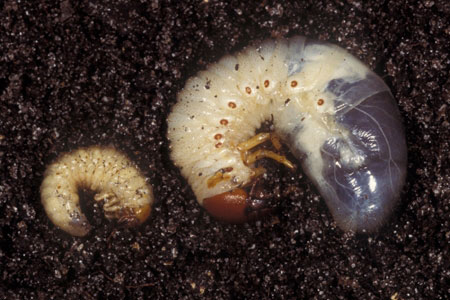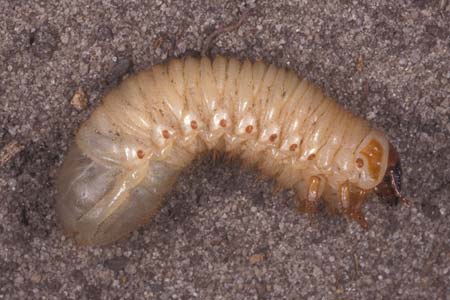Home » Bugs » Lawn Pests »
Active Seasons



Grub Worms Appearance and Size Facts
Lawn grubs are actually the larva form of beetles, such as June bugs and Japanese beetles. Grubs may not be a concern if you find them in small numbers, but too many grubs can significantly damage your grass. Think you have grubs on your lawn? They’ll look like this:
- White with brown head and accents
- Averages 1/2 inch to two inches in length
- Typically have C-shaped bodies and six legs
- Will sometimes appear brown due to their habitats in the soil
Distinguishing Grub Worms From Other Lawn Pests
Grub worms are pretty distinctive, but they can still sometimes be confused with other lawn pests, specifically worms or caterpillars. For example, Armyworms are similarly larval, but they look different and turn into moths, while grubs turn into beetles. While grubs are cream-colored, armyworms are gray and brown with striped bodies. Caterpillars typically have differing colors and patterns, as opposed to grubs, which are a solid cream color.
We provide grub worm treatment in the following locations and their surrounding areas:

Behavior and Habitat of Grub Worms
Lawn grubs often aren’t distinguishable by their behavior because they spend their lives underground, feeding on grass roots. If you don’t see any of the signs of infestation, grubs could still be lingering underground. Unless you notice signs of damage to your lawn or have beetle problems in the spring or summer, grubs aren’t inherently a problem.

Signs of Infestation of Grub Worms
Some of the signs that you’re dealing with a grub problem include brown patches in the grass, which occur when a large population of grubs feeds on your lawn. You may become aware of a grub problem when other animals, like moles and gophers, dig the grubs out of the ground. Another sign of grubs is seeing beetles flying low to the ground, where they’ll lay the eggs from which grubs hatch.

Tips for Prevention of Grub Worms
Since grubs are drawn to moisture in your lawn’s soil, a good step toward preventing them is properly draining and irrigating your lawn. Proper lawn irrigation can help prevent beetles from laying their eggs in the soil. If you regularly deal with grubs in your lawn, turn to Hulett for grub worm control and prevention advice.
Getting Rid of Lawn Grubs
Dealing with a lawn grub infestation on your lawn is a difficult task, especially if you’re trying to handle it on your own. Lawn grubs are notoriously difficult to control, as they are in the soil, so DIY methods can be unsuccessful. When your lawn is infested with grubs, turn to an expert pest control company like Hulett.
Effective Lawn Grub Control Solutions
When you need Florida lawn pest control services for grub worms or another pest, Hulett has you covered. Our pest technicians are highly trained professionals, ready to work with you to solve your pest problems. Check our Florida pest control service areas to see if we cover your home.
For more information on our Florida pest control services, check out our FAQ. Schedule your free inspection today and take the first step toward solving your lawn grub problem.



